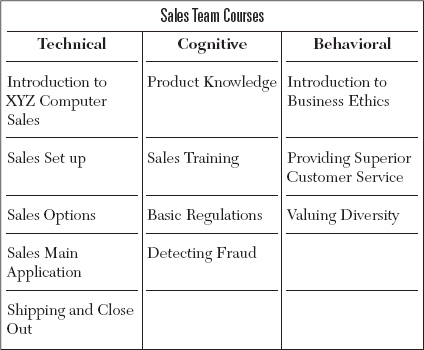Competency-Based Curriculum
Training professionals often struggle to develop learning programs that make sense for their organizations and support the development and growth of employees. A curriculum is a set of courses designed to prepare the learner for success in a job. A well-constructed curriculum builds the skills and capabilities of your workforce and provides employees with a document through which their learning can be monitored.
Traditionally, training curricula have been designed around hard and soft skills; this Infoline shows you how to build curricula based upon developing three key employee competencies. A competency is a set of skills, knowledge, and attitudes required to carry out a job in an organization. A competency drives outstanding performance in a job and helps distinguish a truly excellent performer from a mediocre one. You will use these three competencies in your curriculum design:
• technical
• cognitive
• behavioral.
■ Technical Competency
Technical competencies consist of the specialized knowledge and skills in areas that relate to technical user applications. Technical competencies can also include any type of hard skill. Some examples are how to
• use a specialized computer program
• sign up a new member or customer
• write in shorthand
• perform CPR.
Technical competencies should be the first set of tasks that you review when performing your analysis.
■ Cognitive Competency
Cognitive competencies may sometimes be difficult to identify. in order to come up with these competencies, consider skills such as
• thinking
• reasoning
• problem solving
• strategizing
• remembering.
Training courses can be built around a single cognitive competency. For example, courses may address topics like product knowledge, fraud detection, regulations, compliance, or sales training.
■ Behavioral Competency
Behavioral competencies can be thought of as “actions.” This group of courses includes training topics geared to guide employees' interactions with co-workers, customers, and colleagues. A few examples of behavioral competencies are
• business ethics
• emotional intelligence
• customer service
• conflict resolution
• interpersonal skills
• leadership
• diversity
• teamwork.
As with cognitive competencies, training courses can be built around an individual behavioral competency.
This Infoline will show you how to take a competency-based approach to developing job-specific learning programs. You will learn how to
• analyze employee job tasks and organize them around competencies
• draft and revise a curriculum using a collaborative process
• guide employee growth and measure your success.
Sample Curriculum
This sample shows what a finished curriculum will look like with its courses arranged under competencies.

